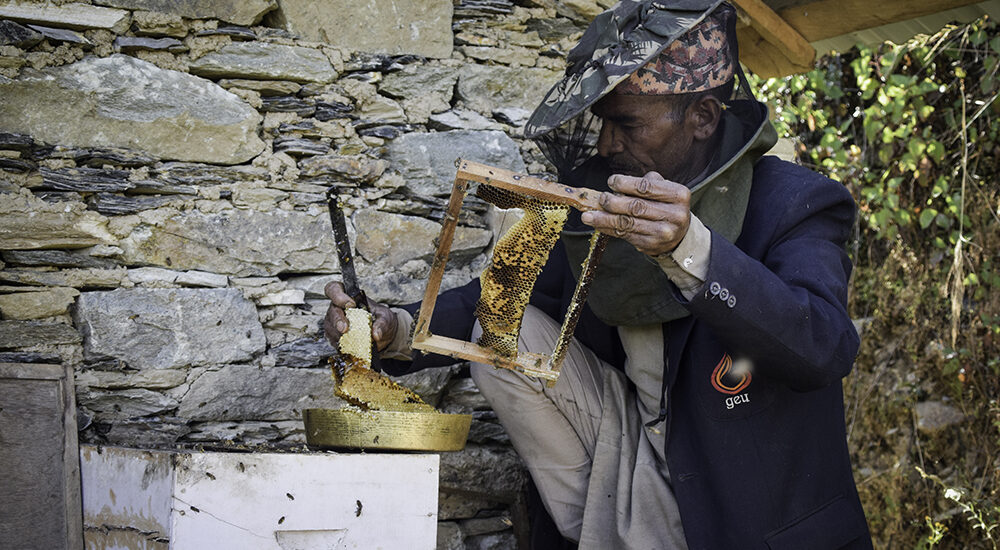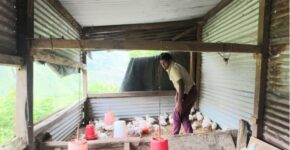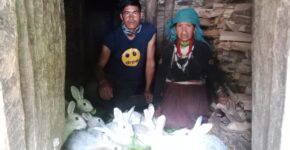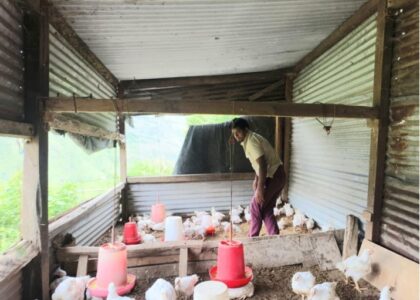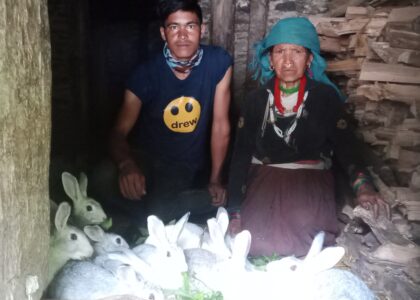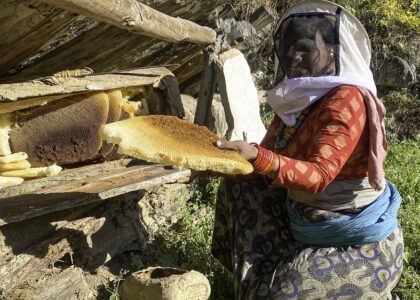Dhurba Bohora (30 years old) has a bee farm at the top of a very beautiful hill in Thalara-4, Bajhang. The name of his beekeeping firm is ‘Jai Chandra Bee and Animal Farm, which is named after his parents. Beekeeping has its own fascinating story.
At that time, his grandfather brought a beehive from India and kept it at home. “Perhaps because of the greenery, fruits, and flowers, slowly the bees began to come and live in the hive.” His father then added some hives to that. When asked when he started beekeeping, he says, “It’s been 8–10 years since we started raising bees, and it’s been 5–6 years since we were raised by bees.” That means it can be clearly understood that bees give good income.
He currently has 30 hives, including 26 mude (traditional) hives and 4 modern hives. The hives are made of the strong wood of Uttis (Alnus Nepalensis). Because of the cold, the hives are made thick (1–15 inches) to help bees escape from the cold. He says that he can build a hive in his own village himself if he receives training in hive-making. Because of this, the business can be further enhanced by increasing the beehive.
The hive contains ‘cerena bees’, a common bee found in the hills of Nepal. A suitable place for bees, a clean climate, and juicy flowers and fruits make the honey produced free of pesticides. So, he never has to give fodder (a sugar bag) to the bees, even in the rainy season. Honey is mainly extracted twice a year (May/June and Kartik/November). A hive gives up to 10 kg of honey in a year. Being pesticide-free, this honey is also perfect for medicine.
Honey is easily sold by its own firm. It is sold at Rs. 1500 per kg. 2 quintals (200 kg) of honey are traded in a year. He has been supporting his family’s household expenses and education through his income.
Inspired by his father, he has been learning and doing beekeeping since his childhood. He says, “Beekeeping requires more experience than training.” He was keeping bees in the old mude hive and was further supported by the training and modern hive support of the Sirjana project. Modern hives are easier to extract, and less honey is wasted. It also protects against insects, butterflies, hives, and other diseases affecting bees.
“Beekeeping doesn’t consume much energy or time. All you need is a hive, which doesn’t even cost much. If I had had enough training, I could have made a hive myself. No feeding, no weeding, no need to look at it in the morning or evening; it’s just a job of extracting honey; it gives lots of money, he cheers. In fact, he really did not raise the bees; the bees raised him, as he said.
As there is enough grass in their place, they also raise goats. He now has 32 goats. He is happy that the project has helped him build a modern shed. In a modern goat shed, the goat’s urine easily flows down, so when the shed is clean, less work is required. Along with goat rearing, he has also started vegetable farming. With the help of the project, he also got some hybrid vegetable seeds. Due to his hard work and willpower, he has managed to do all-round business.
The project, which helped him with training in modern beehives and invested in goat sheds and vegetable farming, gave him more energy and willpower. Due to this motivation, he is thinking of increasing his business further. After getting training in making hives, he wants to make hives himself from the alnus Nepalensis plant found commonly in his village.
For most of the young people of his age who go to or want to go to India and the Gulf countries to earn their living, he is a dynamic source of inspiration for others to follow and get inspired by. He is grateful for the work and support he received from the Sirjana project.


